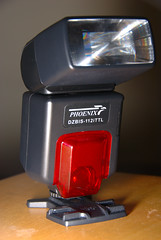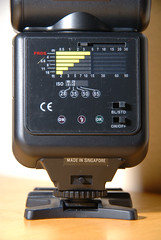 So you likely know that I recently dropped and broke my Nikon SB600 flash. Disappointed as I was about this, I was already thinking of how I’d replace it. My searches for Nikon compatible flashes had always included these apparently super affordable Phoenix flashes. Now, of course, I was always very suspicious of these for a couple of reasons. First, in all the auctions and other sites selling these I never saw information indicating if this had ANY manual control, and there was never a picture of the rear panel of the unit! Second, there weren’t really any reviews of it online. I found a few, but usually it was on something like Amazon where it was fairly apparent that those reviewing were (at best) uninformed users who wouldn’t know the difference between a “good” flash and a bad one.
So you likely know that I recently dropped and broke my Nikon SB600 flash. Disappointed as I was about this, I was already thinking of how I’d replace it. My searches for Nikon compatible flashes had always included these apparently super affordable Phoenix flashes. Now, of course, I was always very suspicious of these for a couple of reasons. First, in all the auctions and other sites selling these I never saw information indicating if this had ANY manual control, and there was never a picture of the rear panel of the unit! Second, there weren’t really any reviews of it online. I found a few, but usually it was on something like Amazon where it was fairly apparent that those reviewing were (at best) uninformed users who wouldn’t know the difference between a “good” flash and a bad one.
In spite of those facts though, I convinced myself that spending $80 to find out if the thing is any good couldn’t hurt, right? Wrong! The thing got shipped reasonably quickly to me from the eBay seller, and upon opening it up it seemed like it had some potential. Yes, it was kinda cheapy plastic and felt light, but that is what I expected for something so inexpensive. The real dissappoinment came when I put it on my camera, and snapped a few shots. You can see the results here. Needless to say this thing, even when doing full power pops, can’t provide enough light to expose a shot properly. This, in spite of the fact that it’s a big, imposing looking flash. They did a lot to try to make it look like an SB800, hinting that it might actually have some decent performance.
 So now, to answer some questions I had about it. This is strictly intended for use with iTTL. The back panel just contains a couple switches, one to turn it on, and one to switch “modes, and a guide for ISO/zoom/distance that this flash supposedly covers. The switch to change between “BL” and “STD” has absolutely no influence on the poor performance. Using a Cactus v2s to pop it seems to do only a very low power pop and the flash does not seem to recharge afterward.
So now, to answer some questions I had about it. This is strictly intended for use with iTTL. The back panel just contains a couple switches, one to turn it on, and one to switch “modes, and a guide for ISO/zoom/distance that this flash supposedly covers. The switch to change between “BL” and “STD” has absolutely no influence on the poor performance. Using a Cactus v2s to pop it seems to do only a very low power pop and the flash does not seem to recharge afterward.
The zoom is manual which is to be expected, and goes from 28mm to 85mm. When I zoomed it in to 85mm, and fired it I noticed some artifacts from the lens/diffuser which were distracting see here.
My plan was to use it along with a Nikon SC-28 iTTL cable to simulate the way I was using my Nikon SB600 when shooting butterflies on the fateful day that I broke it. I figured that I would lose some convenience having to go with a cable, and zoom the flash manually. I didn’t anticipate that the thing wouldn’t have enough power to expose a frame properly! So if you’re wondering if this thing is any good, and maybe thinking you’re willing to give up a little performance and convenience for a STEAL of a flash, think again. You do, sadly, get what you pay for.
For what I did actually do to replace my Nikon SB600, stay tuned. I went on a bit of an ill advised shopping spree, and have some exciting stuff headed my way!